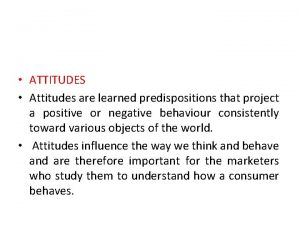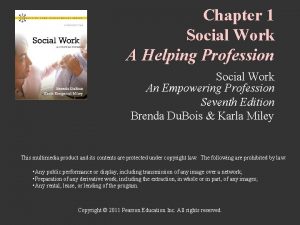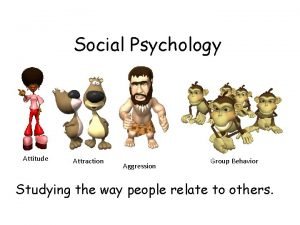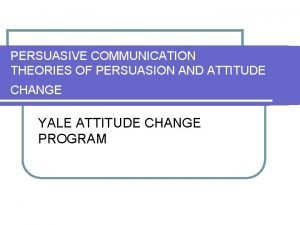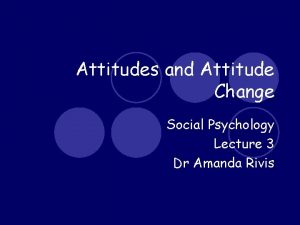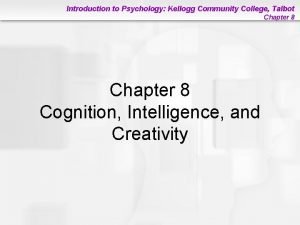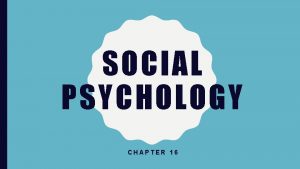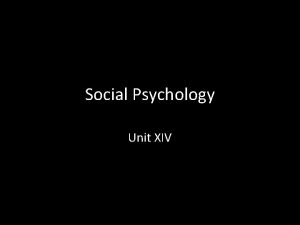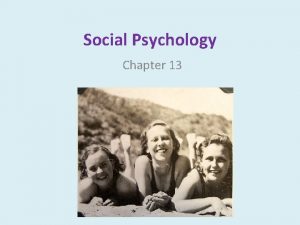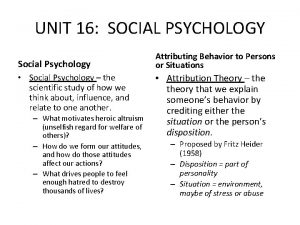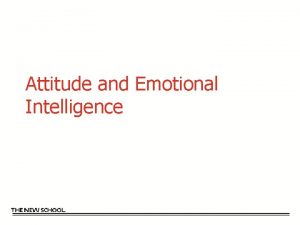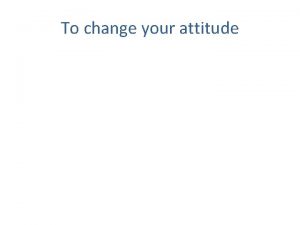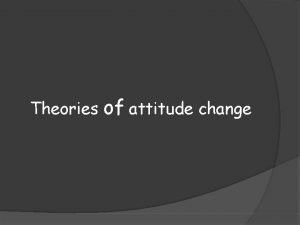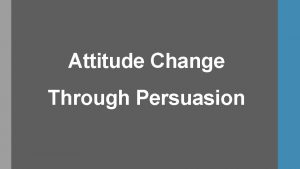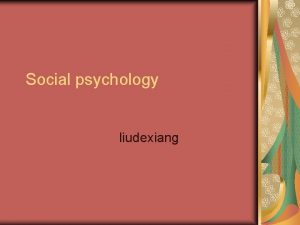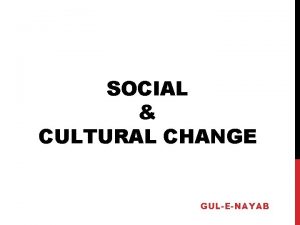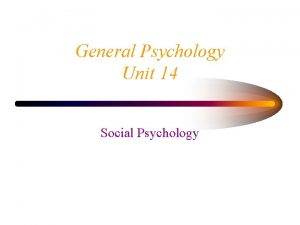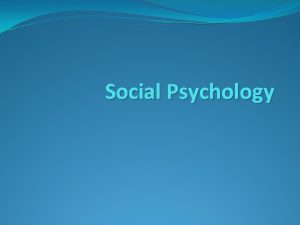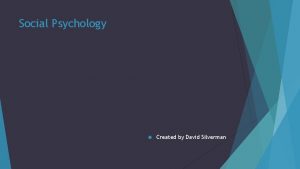SOCIAL PSYCHOLOGY ATTITUDE FORMATION AND CHANGE Attitude set








































- Slides: 40

SOCIAL PSYCHOLOGY

ATTITUDE FORMATION AND CHANGE • Attitude = set of beliefs & feelings about anything. Attitudes are evaluative (+ or -) • Much research done on how to affect people’s attitudes (marketing/advertising) • Mere exposure effect – more you’re exposed to it the more you’ll come to like it • Characteristics of communicator – attractive, famous, experts • Characteristics of audience – more educated people less likely to be affected by advertising • Central route to persuasion – persuaded by evidence/facts • Peripheral route to persuasion – persuaded by superficial cues like the speaker’s attractiveness

COGNITIVE DISSONANCE • Relationship between attitude and behavior. Our attitudes and behaviors do not always match up • Great dissonance or difference between our attitudes and behaviors (hypocrisy) causes mental tension and angst. • Typically we either have to adjust our attitudes or behaviors to bring them back into synch • Ex: if I think lying is bad, but I am in a situation where I am lying to someone close to me - it will cause me great stress. I either need to stop lying and change my behavior or adjust my attitude to justify lying (i. e. everyone lies – it’s okay after all)

COGNITIVE DISSONANCE

COMPLIANCE STRATEGIES • How do you get others to do what you want? • Foot in the Door – get them to agree to a small request and then follow it up with a larger request – can I borrow $5…if you can spare that, I can really use a $20 • Door in the Face – ask for a huge request and when they refuse follow up with a smaller request hoping it will seem reasonable – can I borrow $200? No, well then can you spare a $20? • Norms of Reciprocity – you owe me a favor because I did a favor for you (“The Godfather”)

ATTRIBUTION THEORY • How do we determine the cause/motive of other’s behaviors? • Disposition (part of the person’s inherent traits) • VERSUS • Situational (the person’s behavior is unique to a particular situation)

FUNDAMENTAL ATTRIBUTION ERROR • When looking at the behavior of others we tend to overestimate the importance of dispositional factors (that’s who they are) and underestimate the importance of situational factors (they’re in a tough spot). When we evaluate our own behavior we emphasize situational factors instead of our disposition. • Ex: the guy at the next table who is yelling at his kids is a jerk and a bad father (disposition). When I yelled at my kids yesterday, they were really misbehaving and I was having a bad day (situational). • Zimbardo’s Prison Experiment

FUNDAMENTAL ATTRIBUTION ERROR

OTHER ATTRIBUTION ERRORS • Self-fulfilling prophecy – the expectations we have about others can influence their behavior such that they fulfill our expectation (Pygmalion in the classroom)

OTHER ATTRIBUTION ERRORS • False Consensus Effect – tendency to overestimate the number of people who agree with us • Self serving bias – tendency to take more personal credit for good outcomes than bad ones • Just world belief – we think bad things happen to bad people and good things happen to good people. So misfortune befalls people who deserve it. i. e. the homeless guy on the street must be lazy because it’s a just world and if he was a hard worker he’d have a job


INFLUENCE OF OTHER PEOPLE ON OUR BEHAVIOR

GROUP DYNAMICS • All groups have norms – rules about how members should act • Groups often have specific roles • Social Loafing – often people slack off when a member of a group (difficult to discern individual effort) • Group Polarization – the enhancement of a group’s prevailing attitudes through discussion within the group (if a gun rights person goes to a NRA conference they will leave even more into gun rights)

GROUP DYNAMICS Group Think Deindividuation • Tendency for a group to talk themselves into a bad decision (more likely when group is highly cohesive – like a gang) • People do things within a group they would have never done on their own; they feel anonymous and lose self-restraint. Usually spur of the moment. • Ex: Bay of Pigs • Ex: throwing rocks at cops

GROUP DYNAMICS Social Facilitation Social Impairment • When having an audience inspires you to perform a task better • More likely if the task is simple or well practiced • Ex: the athlete who nails it in a big competition when the stands are full of people • When having an audience makes you nervous and you bomb • More likely if the task is not simple or well practiced) • Ex: the athlete who gets nervous and misses the free throw to lose the game when the stands are full

SOLOMON ASCH - CONFORMITY • Asch immigrated to the US from Poland when he was a teen. Inspired to study conformity from WW II…. . would people conform to a knowingly wrong behavior? Did his experiments in 1951 • In experimental group confederates give blatantly wrong answers and Asch wants to know if participant will conform. Participants are told experiment is on visual perception (deception)

SOLOMON ASCH - CONFORMITY • Match the exhibit line to the lettered line mostly closely matching it’s size. • 70% of participants conformed at least once and @ 33% conformed every time • Control Group – no confederates – participants gave wrong answers less than 1% of the time • http: //www. simplypsychology. o rg/asch-conformity. html

CONDITIONS THAT STRENGTHEN CONFORMITY • One is made to feel incompetent or insecure • The group has at least three people (further increase in group size didn’t yield more conformity) • The group is unanimous • One admires the group’s status and attractiveness • One has made no prior commitment to any prior response • Others in the group are observing one’s behavior • The particular culture strongly encourages respect for social standards

CONFORMITY TAPERS OFF AT ABOUT 3 CONFEDERATES

STANLEY MILGRAM’S OBEDIENCE STUDIES (1961/1962) • Milgram was Asch’s research assistant in is conformity studies. He became interested in a similar concept – would people willfully obey a command if it was a bad command

MILGRAM • Deception – told participants they were studying learning and the effect of punishment on an incorrect answer • Teacher = participant • Learner = confederate • @ 60% (2/3) obeyed experimenter and delivered all the shocks • Not ethical by today’s APA guidelines • https: //www. youtube. com/watch? v =x. OYLCy 5 PVg. M

MILGRAM

FACTORS THAT AFFECT OBEDIENCE • If one has less respect for the authority figure they are less likely to obey (when Milgram used a TA or when he disassociated the experiment from Yale obedience decreased) • If the victim is more personalized (if Milgram introduced the teacher and the learner prior to the experiment obedience decreased).

• Do Asch and Milgram’s experiments jive with Kohlberg stages of ethical development? HOW?


STEREOTYPES, PREJUDICE, AND DISCRIMINATION

• Stereotypes: attitudes/ideas of what members of different groups are like. Stereotypes can be + or – and can be applied to any group of people (racial, ethnic, geographic). Our stereotypes often influence the way we interact with people • Prejudice: negative stereotypes about an entire group of people • Discrimination: ACTION – when one acts on prejudice (prejudice is an attitude discrimination is action based on that attitude) • Examples? ? • Origin of prejudice? Bandura - modeling

STEREOTYPES, PREJUDICES, ETC. • Out group homogeneity – people tend to see their own group (the in group) as more diverse than other groups. We lack familiarity with other groups and see them as all the same • In group bias – we prefer members of our own group. We see ourselves as “good people” and therefore other members of our group must also be good people

COMBATING PREJUDICE • Contact Theory – contact between hostile groups will decrease hostility if groups are made to work towards a common goal that benefits everyone – superordinate goal – the goal must require the participation of all and must benefit both groups of the goal is achieved • Integration of military and public schools did a lot to break down racism in America • “Remember the Titans”

ROBBERS CAVE


AGGRESSION/ANTISOCIAL BEHAVIOR • Instrumental aggression – aggressive act to secure a particular end (John hits his sister to get a toy) • Hostile aggression – no clear purpose for aggression • Causes of human aggression…. ? ? • Frustration Aggression Hypothesis – feelings of frustration make aggression more likely (socio-economic levels, desperation, etc. ) • Social Learning – Bandura and Bobo Doll

PRO-SOCIAL BEHAVIOR • What factors make people more or less likely to help one another? • Bystander Intervention • Diffusion of Responsibility – the more people who witness an emergency they less likely anyone is to intervene. Each assumes someone else will do something and everyone feels less responsible • Pluralistic Ignorance – people decide what constitutes appropriate behavior in a situation by looking to others. If no one seems to think it’s an emergency everyone follows that cue • https: //www. youtube. com/watch? v=z 4 S 1 LLr. Sz. VE

BYSTANDER INTERVENTION

PLURALISTIC IGNORANCE

KITTY GENOVESE HTTPS: //WWW. YOUTUBE. COM/WATCH? V=Q-AUSW 85 QKA&FEATURE=FVWREL


ATTRACTION • What determines who we like? • Similarity – we are attracted to people with similar attitudes, background, and interests • Proximity – nearness – the more time we spent together, the more we like them • Reciprocal Liking – we like people who like us and are nice to us • Self Disclosure – sharing pieces of personal information increases closeness/intimacy/likeness


DECISION MAKING • Approach-Approach – choose between 2 things you want but can’t do both • Avoidance-Avoidance – neither choice is particularly appealing but you have to choose one • Approach-avoidance – the choice has both good and bad outcomes • Multiple approach avoidance – choosing between several alternatives – each has multiple advantages and disadvantages • Examples?
 Total set awareness set consideration set
Total set awareness set consideration set Training set validation set test set
Training set validation set test set Central persuasion example
Central persuasion example Social behavior psychology definition
Social behavior psychology definition Social psychology ap psychology
Social psychology ap psychology Social psychology is the scientific study of
Social psychology is the scientific study of Social thinking and social influence in psychology
Social thinking and social influence in psychology Apa itu social thinking
Apa itu social thinking Attitude formation
Attitude formation Formation initiale vs formation continue
Formation initiale vs formation continue Types of attitude
Types of attitude Attitude and value change
Attitude and value change Social change in social work
Social change in social work What is the overlap of data set 1 and data set 2?
What is the overlap of data set 1 and data set 2? Overgeneralized idea about a group of people.
Overgeneralized idea about a group of people. Attitude definition psychology
Attitude definition psychology Social thinking social influence social relations
Social thinking social influence social relations What is the yale attitude change approach
What is the yale attitude change approach Characteristics of attitudes
Characteristics of attitudes Neural pruning ib psychology
Neural pruning ib psychology Personality vs character
Personality vs character Concept of formation
Concept of formation Defense mechanism
Defense mechanism Concept formation in lifespan psychology
Concept formation in lifespan psychology Molar enthalpy formula
Molar enthalpy formula Bread toasting: gas formation color change light emission
Bread toasting: gas formation color change light emission Definition of enthalpy change
Definition of enthalpy change Chemical change formation of precipitate
Chemical change formation of precipitate Chemical change formation of precipitate
Chemical change formation of precipitate Hess law for combustion
Hess law for combustion Bounded set vs centered set
Bounded set vs centered set Fuzzy theory
Fuzzy theory Crisp set vs fuzzy set
Crisp set vs fuzzy set Crisp set vs fuzzy set
Crisp set vs fuzzy set Surjective vs injective
Surjective vs injective Physical change
Physical change Absolute change and relative change formula
Absolute change and relative change formula Difference between physical change and chemical change
Difference between physical change and chemical change Change in supply and change in quantity supplied
Change in supply and change in quantity supplied Examples of physical vs chemical changes
Examples of physical vs chemical changes Rocks change due to temperature and pressure change
Rocks change due to temperature and pressure change











